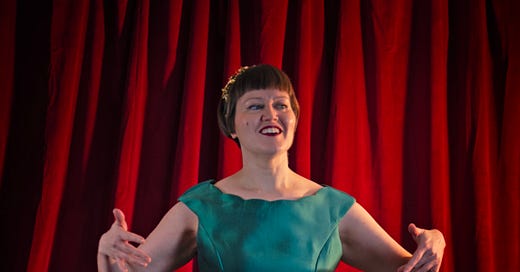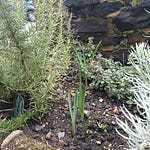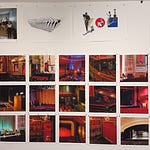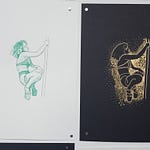You’ve made new artwork taking a new direction. And then you do an artist’s talk or someone visits your studio and find yourself talking about the work. On reflection, though, you are unsure if what you said was relevant and you wonder if what you said might have been off-topic or personal. I find this happens to me when I’ve made new work and I’m not sure what it is.
Before the work has landed and the insight has come, we can find ourselves speaking around the work in ways that might feel exposing and don’t guide the listener deeper into the work. It’s important to protect the tender time of not-knowing when you are still making the work. However, at some point, we must share new work. And so, I write this to help you navigate how you might talk about your work, purposefully, truthfully, and incisively, without pinning it down, before you sense what it is.
I think about how every body of work we make is supported by a scaffold that an audience does not see. Here I envisage a theatre stage with scenery—from the front, there is a visual tableaux that makes sense, and at the back, the view is entirely different. In our art practice, the unseen scaffold is composed of everything that went into the process of making the work: material experimentation and testing, early versions, research, influences, art seen, books read, and advice received. All the the leg work. All the unconscious work that underpins creative practice. The scaffold is for us to make the work, it is not part of the work, and so it is not for public viewing. However, sometimes curators, collectors, commissioners, or writers want to know on a deeper level what drives the work: they want a peek at the scaffold. But to view the whole scaffold would not be interesting–there’s too much on there.
I see the scaffold as informing what we put on the public stage. The scaffold enables us to make the work, write our artist statement, and communicate the work. The scaffold though, is whatever we need it to be, and there’s no reason for us to edit it or make it look good for anyone else. We don’t need that extra pressure.
Here’s my suggestion. To enable you to confidently share a focussed view of some of the scaffold material—jot down on a large sheet of paper, mind-map style, all of the things you are aware of that informed the work. For example, all the thoughts, impulses, experiments and research. You might need to do this over a period of time. It’s probably best to do this in your workspace where you can see some of the physical scaffold. Some of the more internal or emotional scaffold might come into your consciousness after a day or two. Once you can see a project’s scaffold, use a highlighter pen to identify what feels comfortable, accurate, and useful for you to share. You could even make a new sheet and see how it looks together. There’s no reason at this stage for there to be a linear narrative across this material. In fact, it can be quite exciting for a listener to hear you begin to make sense of your scaffold material for the first time. The task though, is to stay with what you’ve mapped—the material you feel comfortable discussing. You don’t need to be guided by anything more than your intuition or hunches. But this can give you some sense of clarity before you’ve arrived at your deeper sense-making insights. And it can help you to feel empowered and intentional rather than over-sharing and exposed.
It might be useful to keep your two mindmaps in the studio while you work—the full scaffold inventory map and the public-facing edit. The latter might serve as a starting point for your artist statement on the work.
I use the analogy of the scaffold a lot in my mentoring—I think it’s a useful image that can illuminate the parts of the process that might be unconscious or skipped over. But examining our scaffolds can unlock more creative potential and new directions. I hope my thoughts on the scaffold help you in your making process.













Share this post